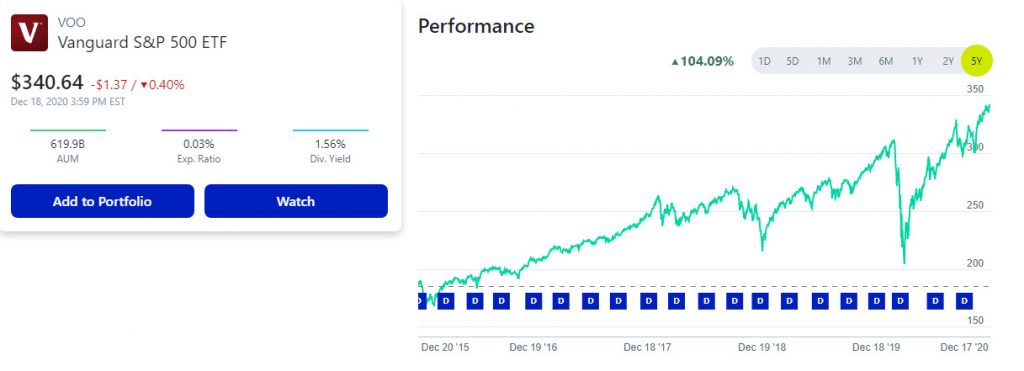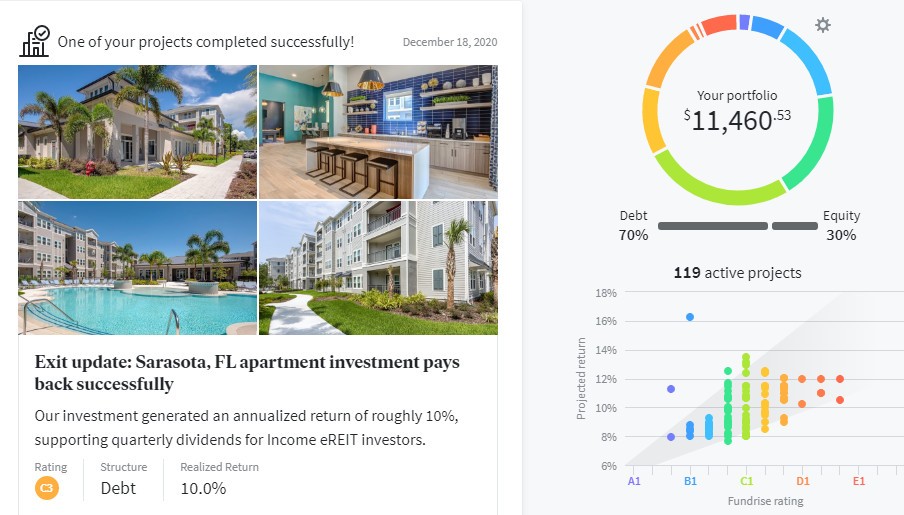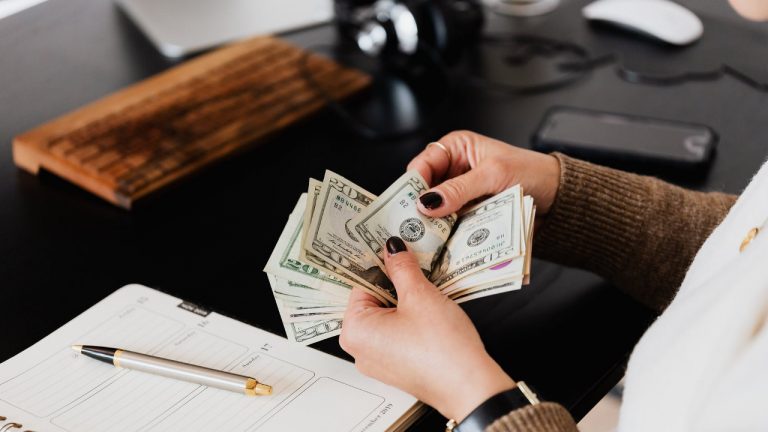So you have $10,000 and are thinking about investing it. If you’re not sure were to begin, here our our top strategies for investing like a millionaire.
You may have suddenly inherited some extra money or saved up enough to have an extra $10k. Investing it is a great way to grow your long term wealth and build a passive income stream.
Congratulations on getting to this point financially. It is a big step to have enough money to be able to think about options for investments. Based on my experience, here are my top tips to build your net worth.
Don’t quite have $10k saved up yet? Here are some ideas on where to invest starting with only $1,000.
Pay Off Your High-Interest Debt
If you have an extra $10,000 in cash, the first thing you should do is pay off any high-interest debt. This would be any credit card debt and potentially student loans that are 8% or higher.
If you have any debt that has a high interest rate, it makes sense to pay that off first to free up your monthly cash flow. By getting rid of your debt, all of the money that was previously going to that can be redirected to your savings or investments.
Mathematically, it also makes no sense to continue to pay interest on debt that charges you 15% or higher. Most investments will average 10% to 12% returns, so you are losing money if you decide to invest instead of paying off your debt.
For anyone that has high-interest debt, the number one thing you should do with your $10k is to pay off that debt.
Make Sure You Have Enough Savings
Next, determine your short and long term financial goals. Take a moment to assess your current financial standing and how much you have saved.
Do you have a full six month emergency fund? If not, I highly recommend putting your $10,000 towards an emergency fund to help cover an unexpected costs.
Are you expecting any expenses in the next year or two that you might need this money for? Want to buy a house, car, or go on a vacation? If so, it probably doesn’t make sense to put it into stocks that have higher risk.
In both of these cases, it would be better to put you $10k into a high yield savings account that is liquid and low risk. You’ll be able to pull it out whenever you need and give you peace of mind of having enough cash. Continue to save money until you have more to be able to invest.
Consider Investing in Your Home Equity
Another safe option is to put some of your money into your own home. If you have a mortgage at 4% interest, paying is down gives you a guaranteed rate of return of 4%. Especially in times of market volatility, this could be a good way to make sure you see a return on your investment.
Paying down your mortgage can also help you reach financial independence by eliminating your debt. This will increase your monthly cash flow and allow you to live comfortably on a smaller income.
However, you may not need to use the $10,000 you saved on your mortgage if you are already paying a little extra each month. By adding extra principle each month, you can still pay off your mortgage faster while using your other cash to invest at higher interest rates.
If you already have an emergency savings fund, cash to cover other expenses, and feel comfortable with your debt, it’s time to start investing.
Set Long Term Goals
Once you are comfortable that you have enough cash on hand, you should start thinking about investments that will make more interest.
Keep in mind that you should treat investments as long term goals and those funds shouldn’t be touched for at least 5 years. Day trading and constantly moving investments generally perform worse than just staying with one strategy. There are also tax ramifications for many investments if you don’t hold them for at least a year.
I am a firm believer in holding investments for the long term. Do enough research up front to form a strategy and then believe in that over the years. Be sure to understand your level of risk that you are willing to accept with your investments.
Of course, there are times when it makes sense to adjust your portfolio but you shouldn’t be doing this every month.
As you get into investing your $10,000, be comfortable with the fact that that you will make money by sticking with a long term strategy.
How Do Millionaires Invest Their Money?
If we want to become a millionaire, we should learn from millionaires and their success. One of the common truths across most millionaires is that they have multiple income sources. They do not rely on having just one salary and make sure that they are making money from an average of 7 different places.
According to WalletHacks research, millionaires own assets that appreciate over time. Real estate, especially their own home, is a huge part of their strategy. Owning stocks and bonds, including dividend stocks, is another important piece in growing net worth.
The key takeaways from studying millionaires are:
- Build multiple income streams through businesses, jobs, and side hustles
- Create passive income sources to make your money work for you
- Own appreciating assets like real estate, stocks, and bonds
How to Get Started Investing $10,000
When you have $10k ready to invest, take some time to do enough research to determine exactly what you will do with it. The worst thing would be to put your money into an impulse investment that you may regret later on.
My number one tip with investing is to diversify. Don’t put all of your money into one bucket.
All investments have different levels of risk and rewards. High risk investments will have higher interest rates, but also have the potential to lose all your money. Low risk investments won’t make as much interest and may not be worth it.
By diversifying, you can minimize the impact of a particular holding doing poorly. It will spread the risk around and even out your overall performance over time. When one investment may lose value, another one may go up so that you don’t lose as much value.
As you get started investing your money, look to put your money into a few of these categories and industries. Here are my top picks for how I would invest $10,000.
1. Buy a S&P 500 Index Fund
An S&P 500 index fund tracks the performance of the top 500 companies in the Standard & Poor market. These are the most stable and high-performing companies, so they have historically seen strong performances.
Like any individual stock, an index fund can lose value in the short term with market dips and recessions. That said, S&P 500 index funds have seen double digit growth when averaged over multiple years. When held as a long term investment, they have historically made significant returns over 10% every year.
S&P 500 index funds automatically diversify your risk across 500 different companies. It will almost always outperform even the best day traders and expert stock picks.
For beginners up to seasoned investors, choosing an index fund is one of the best ways to reliably build your wealth.
Index funds can be purchased through most investment platforms or a broker. I personally use M1 Finance to invest in the Vanguard S&P 500 ETF (VOO). It has a low expense ratio of 0.03%, a dividend yield of 1.56%, and has averaged growth of almost 21% annually over the past 5 years.

If you use M1 Finance, it’s easy to search for VOO and add it to your investment “pie”. You’ll be able to start investing even with a small amount and continue to contribute over time.
2. Purchase Crowdfunded Real Estate
The stock market saw a dip from COVID but has been at all time highs over the past few years. This is great for investors but also scares me a bit knowing that, eventually, there will be another recession. To help mitigate this risk, and because I am naturally a bit conservative, I like to invest in real estate.
Real estate helps to diversify your holding away from the stock market. Even though it can be affected by a struggling economy, the real estate market won’t track the stock market exactly. It is usually more stable but you still want to be aware of housing bubbles.
If you only have a few thousand dollars to invest in real estate, you probably won’t be able to buy actual property. Even if you could find cheap property, I actually don’t recommend trying to buy one piece of land or a house with your first $10k.
Instead, invest in crowdfunded real estate to buy small pieces of multiple properties. My platform of choice is Fundrise, but there are other options like DiversyFund or CrowdStreet.
With Fundrise, you can start with as little as $500 and the system will split your money across dozens of properties. You earn money daily through dividends that can be paid out or reinvested. Over time, you will also earn appreciation that comes from the property value increasing.
Be aware that investing in real estate is illiquid and you should expect to leave your investment for at least 5 years.

Fundrise makes it easy to get started with real estate investing and it is a great option for diversifying your holdings away from just stocks.
3. Buy Individual Stocks
In addition to investing in an index fund, you can choose certain individual stocks to help boost your portfolio growth. Individual stocks are inherently riskier because you can lose your money if that company has a terrible year or suddenly goes bankrupt.
For this reason, I would never recommend investing in just one or two individual stocks. Instead, pick at least 10 or 20 stocks you feel comfortable with and add them to your larger portfolio that includes index funds and real estate.
Always do your research and understand the companies that you want to invest in. I like to pick large, stable companies that have a track record of solid performance for many years. Blue chip, dividend aristocrats are a good starting point to see stable returns.
You can also mix in other growth stocks that might be a little riskier but have high returns. For example, if you were lucky enough to find Amazon in 1997 and had invested $100, you would have $129,186 in 2020.
When you are picking stocks, take into account their dividend history, price-earnings ratio, and historic performance over the past 5 to 10 years. I recommend only investing in companies that you understand their business model and believe that they are in an industry that will continue to do well for years to come.
4. Invest in Bonds
Like stocks, bonds can also be purchased on your trading platform to be included in your portfolio. Bonds are essentially a loan that is given to a borrower, usually a company or government, for a fixed rate of interest. By owning shares in the bonds, you can earn that rate of interest.
Bonds typically generate lower interest rates but are much more stable than stocks. If the stock market crashes, bonds will normally perform the same, or go up. They are a good hedge against stock market drops and are a great way to consistently earn at least 3% annually.
If you are younger in your life, you may want to minimize the amount of bonds you have just because you have more time to wait out any drops. However, they can be a great tool to stabilize your portfolio if you are looking to retire in the next few years or have upcoming expenses.
Throughout 2020, I held a healthy amount of bonds in my M1 Finance account because I suspected that there would be a stock market drop. I’m glad I did, since we did face the COVID recession that tanked many stocks. At the same time, I was able to earn between 6.52% and 8.97% on my bonds.
5. Peer-to-Peer Lending
As you’re building your investment portfolio, peer-to-peer lending is an option that can help to diversify your holdings. P2P lending can tend to be a little riskier when working with individual borrowers, so be sure to be comfortable with the level of risk.
The upside is that you can earn a consistent and sizeable interest rate that will help your money grow. I personally like MyConstant since it currently provides up to 7% interest rates with only 30 day terms. MyConstant also helps to reduce the risk by holding crypto collateral from the borrowers, so I feel relatively secure knowing I’ll get paid out.
While I don’t recommend putting too much money in peer-to-peer lending investments, it can be a helpful tool to build your overall portfolio.
How I Would Invest $10,0000
If I were to go back in time and invest my first $10k, I would diversify that money across all five categories described above. Here is the breakdown that I would personally use when starting out.
While this is an example for how I would invest, the best allocation for you may be a little different. I am not a financial advisor and am just sharing my practical experience, so be sure to decide what works best for you.
My breakdown would look something like:
- S&P 500 Index Fund: 40%
- Crowdfunded Real Estate: 20%
- Growth and Dividend Stocks: 20%
- Bonds: 15%
- Peer-to-peer Lending: 5%

As you get older and have more money to invest, this allocation may change a bit to reach your goals.
During periods of market uncertainty, it may make sense to increase your amount of bonds and real estate. If you want to be more aggressive to earn greater returns, increase your amount of stocks.
By following a similar plan to diversify your investments, you’ll mitigate your risk while maximizing your returns over the long run.













